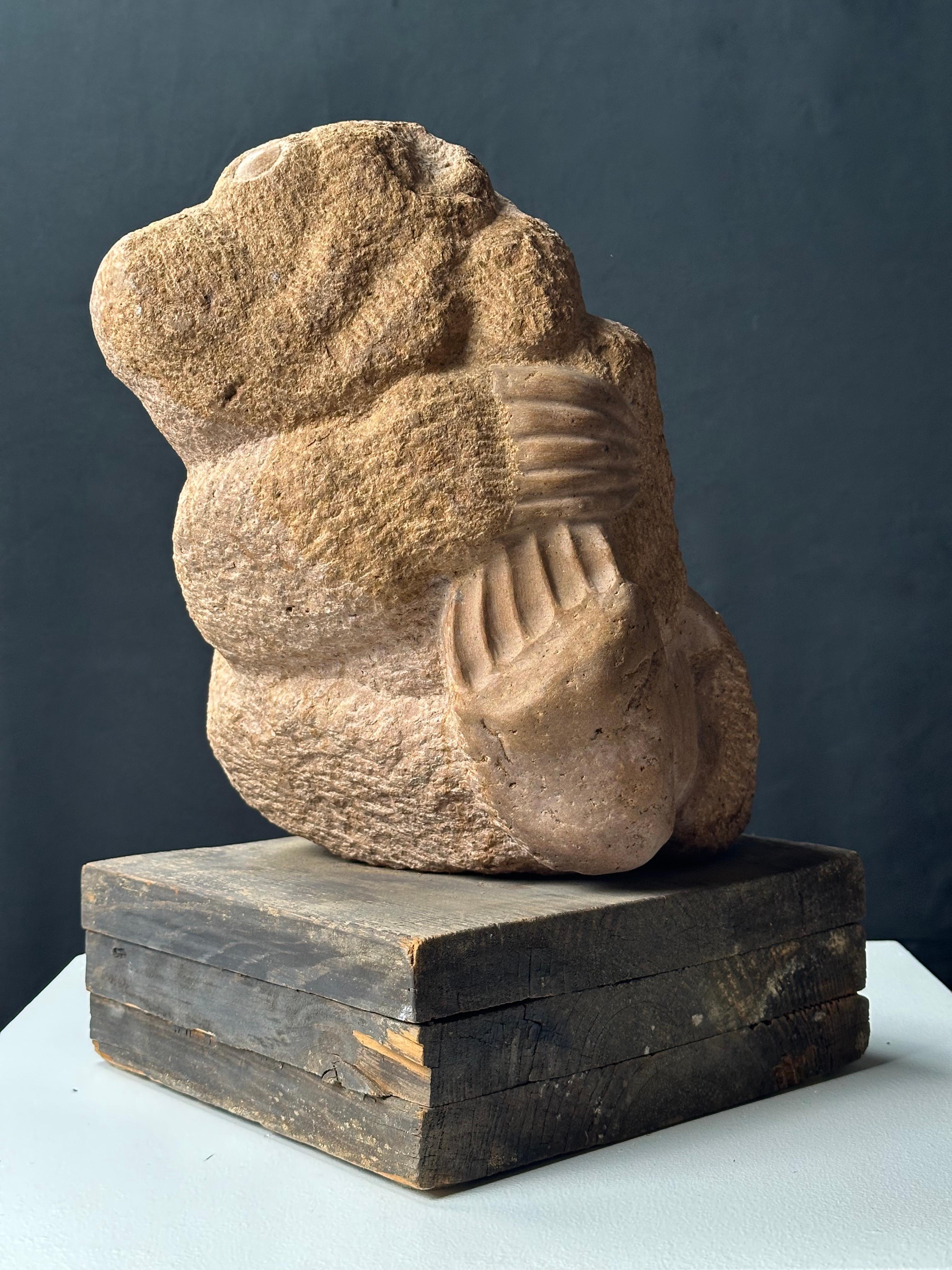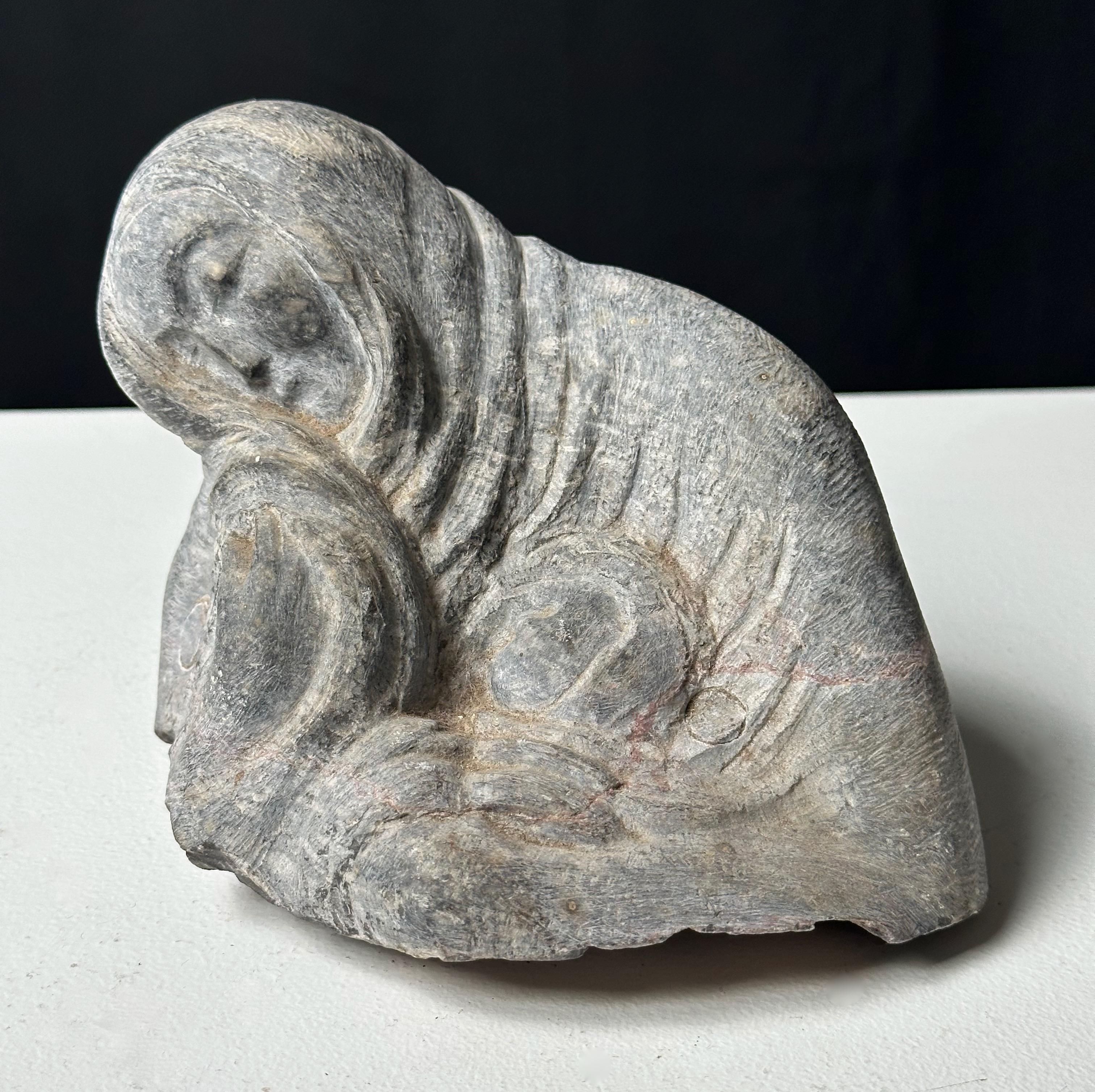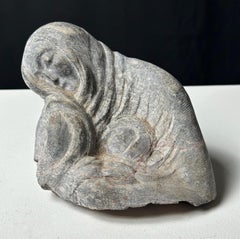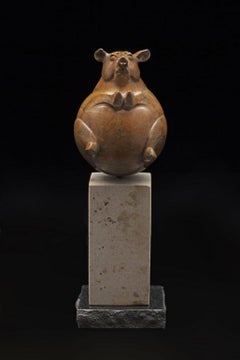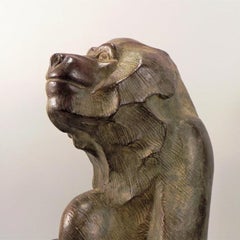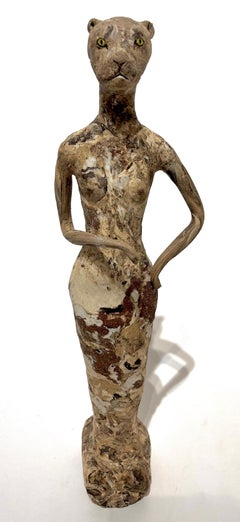Möchten Sie mehr Bilder oder Videos?
Zusätzliche Bilder oder Videos von dem*der Anbieter*in anfordern
1 von 13
Mark MorrisonPavianca. 1940
ca. 1940
2.200,19 €
4.400,39 €50 % Rabatt
Angaben zum Objekt
Mark Morrison (1895-1964)
Pavian, ca. 1940
Nussbaum geschnitzt und verwittert
12" breit, 12" tief, Höhe: 26,5"
Bitte beachten Sie, dass die Unterseite nicht ganz eben ist und das Stück nach rechts geneigt ist. Für die Anzeige, empfehlen wir eine kleine 1/2-Zoll-Holz-Zwischenlage unter eingefügt, wie wir in unserer Auflistung Fotos hier haben.
Provenienz: Nachlass von Mrs. Mark Morrison.
Geboren:
Kingfisher, OK
Bildung:
Universität von Missouri
John Flannagan, Betreuung und Privatunterricht ca. 1940
Liga der Kunststudenten mit William Zorach und Jose de Creeft
Ausgestellt:
Sculpture Guild Annuals
Audubon Künstler Jahrbücher
Nationale Akademie für Design/Jahrbücher
Jahresberichte der Pennsylvania Academy
Metropolitan Museum Artists for Victory, 1942.
Museum der schönen Künste Newark
Whitney-Jahrbücher
Internationale Ausstellung, Fairmount Park, Phila. 1950
Nebraska Bildende Kunst
Ausstellung im Metropolitan Museum, 1951
Kunstfestival Boston
National Sculpture Society Jahresberichte
Mitgliedschaften:
Sculpture Guild, Inc.
Audubon Künstler
Auszeichnungen:
Ellen Prinz Speyer-Preis, N.A. 1950
Architects League of New York, Avery Award, 1958, 1959.
Museum Collections:
Metropolitan Museum of Art
Nationale Akademie für Design/One
Akademie der Schönen Künste von Pennsylvania
Whitney Museum für Amerikanische Kunst.
Museum der Schönen Künste, Universität von Arizona
Mark Morrison begann sein Leben als Bildhauer, als er kurz vor seinem beruflichen Ruhestand stand. In den späten 1930er und bis in die 1940er Jahre hinein nutzte er, wie viele der jüngeren Künstler in New York City, die zahlreichen Akademien, Museen, Lehrer und Mentoren, die die Stadt bot. Vor seinem Tod studierte er bei John Flannagan und anschließend bei Jose de Creeft und Williams Zorach an der Art Students League. Da er sich von den Ideen der direkten Schnitzbewegung angezogen fühlte und ein gutes, gründliches Handwerk beherrschte, nutzte er das wachsende Interesse der Öffentlichkeit an einer neuen amerikanischen Bildhauerei und machte sich schnell zum Zeitgenossen seiner Lehrer. In den 1950er Jahren stellte er mit ihnen aus, verkaufte, nahm an Wettbewerben teil und gewann Preise. Er war ein Bildhauer mit einer sicheren Hand, einem Kopf für die Akademie, Geduld und Versprechen. Morrison starb plötzlich im Oktober 1964, nachdem er im selben Jahr seine zweite Frau geheiratet hatte. Mrs. Mark Morrison bot ein kleines Stück für eine weitere Ausstellung bei der Sculptors Guild im Jahr 1965 an. Das Werk wurde bis 2025 nie wieder gesehen.
Morrison wurde am Neujahrstag 1895 in Kingfisher, Oklahoma, geboren, einer kleinen ländlichen Stadt, die noch nicht zur Union gehörte. Er war das einzige Kind eines protestantischen Pfarrers und einer von nur 16 Schülern, die 1913 die High School in Higginsville, Missouri, abschlossen. Er studierte Landwirtschaft an der Universität von Missouri und verließ sie irgendwann, um in die Armee einzutreten. Er würde den Rang eines Majors erreichen. Nach dem Krieg heiratete er seine erste Frau, zog nach New York und begann für Tidewater Oil zu arbeiten. Er arbeitete dort bis 1954 und ging als Vizepräsident in den Ruhestand. Zu dieser Zeit wohnte er in der 8 W. 13th St., sein Studio befand sich bereits in einer Ecke des Kellers seines Wohnhauses.
Die früheste Ausstellung, in der ein Werk von Morrison gezeigt wurde, war die Ausstellung Artists for Victory im Metropolitan Museum im Jahr 1942. Zu Beginn desselben Jahres beging John Flanagan Selbstmord. Der Tod war ein schrecklicher Schlag. Flannagan hatte einen tiefgreifenden Einfluss, indem er sowohl technische Anweisungen als auch philosophische Ratschläge gab. Die Bedeutung ihrer Freundschaft in den 1930er Jahren kann gar nicht hoch genug eingeschätzt werden. Morrison ist Teil von Flannagans künstlerischem Vermächtnis, sein einziger bekannter Schüler während des kurzen Lebens des mythischen Bildhauers. Beide Künstler wurden im selben Jahr 1895 geboren und kamen aus ländlichen Regionen der USA nach New York: Oklahoma bzw. North Dakota. Im Gegensatz zu Morrisons stabilem Leben war Flannagan ein zutiefst unruhiger, schwieriger, ungeduldiger und unberechenbarer Mann. Sein Lehrer muss in Morrison einen verwandten Geist und einen Künstler mit außergewöhnlichem Potenzial gesehen haben, um ihn als Mentor zu gewinnen. Morrison wiederum muss ein einfühlsamer und geduldiger Schüler gewesen sein, der erkannte, wie wichtig es ist, über persönliche Unzulänglichkeiten hinwegzusehen, um ein künstlerisches Genie zu unterrichten.
Morrison stellte fast 10 Jahre lang nicht regelmäßig aus und verbrachte diese Zeit damit, sich weiterzubilden und hier und da auszustellen. Er setzte sein Studium der Bildhauerei an der Art Student League bei Zorach und de Creeft fort und verbrachte die meisten Nächte mit der Bearbeitung von Steinen in seinem Studio. Sein reifer Stil, eine Synthese aus Naivität und Raffinesse, aus dem, was Flanagan "das Bild im Felsen" nannte, und dem geschliffenen, flüssigen Marmor von Zorach, sollte sich bis 1950 klar herausbilden.
Black Swan war im März 1952 in der Ausstellung "In Time and Place" der Sculptors Guild im Museum of Natural History zu sehen. Und die Ausstellung drängt diese Punkte in ihrer Mission, dem Publikum zu einer volleren Wertschätzung der Skulptur zu verhelfen, und dass die Skulptur und die Architektur von Gebäuden wieder gleichzeitig und homogen geplant werden können. Morrisons Schwan war das Herzstück des modernen Wohnzimmers, das von Earnshaw, Inc. In derselben Halle des Museums hatten Morrison und andere Mitglieder der Gruppe ein Jahr zuvor in sieben provisorischen Studios den Arbeitsprozess demonstriert. Er stellte weiterhin in den Guild-Jahrbüchern und den Audubon Artist Annuals aus. Seine Skulptur "Gosling" wurde von der Architects League im Rahmen des Avery-Wettbewerbs 1958 mit einer lobenden Erwähnung bedacht und belegte den zweiten Platz hinter Zorach. Als er 1959 "Grasshopper" ausstellte, gewann er auf Anhieb.
Er hatte sein Studio in ein größeres, privateres Gebäude ein paar Blocks weiter in Greenwich Village verlegt. Bis 1964 wurden seine Werke größer, seine Gruppierungen anspruchsvoller und lebendiger, das Licht und die Natur des Steins selbst wurden stärker berücksichtigt. Er hatte abgenommen und war für einen Mann von fast 70 Jahren bei sehr guter Gesundheit. Sein Tod war unerwartet und unglücklich, wahrscheinlich an einem Schlaganfall. Sein Vermächtnis hat überlebt, weitgehend unbekannt, bis jetzt auf einer kleinen Ranch im Bundesstaat New York.
- Schöpfer*in:Mark Morrison (1895 - 1964, Amerikanisch)
- Entstehungsjahr:ca. 1940
- Maße:Höhe: 67,31 cm (26,5 in)Breite: 30,48 cm (12 in)Tiefe: 30,48 cm (12 in)
- Medium:
- Bewegung und Stil:
- Zeitalter:
- Zustand:
- Galeriestandort:Wilton Manors, FL
- Referenznummer:1stDibs: LU245216317692
Anbieterinformationen
4,9
Platin-Anbieter*in
Premium-Anbieter*innen mit einer Bewertung über 4,7 und 24 Stunden Reaktionszeit
Gründungsjahr 2007
1stDibs-Anbieter*in seit 2015
416 Verkäufe auf 1stDibs
Typische Antwortzeit: 2 Stunde
- VersandAngebot wird abgerufen …Versand von: Reading, PA
- Rückgabebedingungen
Einige Inhalte dieser Seite wurden automatisch übersetzt. Daher kann 1stDibs nicht die Richtigkeit der Übersetzungen garantieren. Englisch ist die Standardsprache dieser Website.
Authentizitätsgarantie
Im unwahrscheinlichen Fall eines Problems mit der Echtheit eines Objekts kontaktieren Sie uns bitte innerhalb von 1 Jahr für eine volle Rückerstattung. DetailsGeld-Zurück-Garantie
Wenn Ihr Objekt nicht der Beschreibung entspricht, beim Transport beschädigt wurde oder nicht ankommt, kontaktieren Sie uns bitte innerhalb von 7 Tagen für eine vollständige Rückerstattung. DetailsStornierung innerhalb von 24 Stunden
Sie können Ihren Kauf jederzeit innerhalb von 24 Stunden stornieren, ohne jegliche Gründe dafür angeben zu müssen.Geprüfte Anbieter*innen
Unsere Anbieter*innen unterliegen strengen Dienstleistungs- und Qualitätsstandards, wodurch wir die Seriosität unserer Angebote gewährleisten können.Preisgarantie
Wenn Sie feststellen, dass ein*e Anbieter*in dasselbe Objekt anderswo zu einem niedrigeren Preis anbietet, werden wir den Preis entsprechend anpassen.Zuverlässige weltweite Lieferung
Unsere erstklassigen Versandunternehmen bieten spezielle Versandoptionen weltweit, einschließlich individueller Lieferung.Mehr von diesem*dieser Anbieter*in
Alle anzeigenAffe
Mark Morrison (1895-1964)
Affe, ca. 1940
Geschnitzter Granit aus New Hampshire
8,5" x 5", Höhe: 16,5"
Provenienz: Nachlass von Mrs. Mark Morrison.
Geboren:
Kingfisher, OK
Bil...
Kategorie
Mitte des 20. Jahrhunderts, Realismus, Skulpturen
Materialien
Granit
3.520 € Angebotspreis
50 % Rabatt
Streifenhörnchen
Mark Morrison (1895-1964)
Streifenhörnchen, ca. 1940
Italienischer Granit
5" mal 4", Höhe: 4 1/8"
Provenienz: Nachlass von Mrs. Mark Morrison.
Geboren:
Kingfisher, OK
Bildu...
Kategorie
Mitte des 20. Jahrhunderts, Realismus, Skulpturen
Materialien
Stein
Zimtbär
Mark Morrison (1895-1964)
Zimtbär, ca. 1950
Gehauener roter Granit
11" breit, 11" tief, Höhe (einschließlich Holzsockel): 15"
Provenienz: Nachlass von Mrs. Mark Morrison.
Gebo...
Kategorie
Mitte des 20. Jahrhunderts, Realismus, Skulpturen
Materialien
Granit
2.200 € Angebotspreis
50 % Rabatt
Madonna
Mark Morrison (1895-1964)
Madonna, ca. 1940
Geschnitzter Stein
7" breit, 5" tief, Höhe: 4,5"
Provenienz: Nachlass von Mrs. Mark Morrison.
Geboren:
Kingfisher, OK
Bildung:
...
Kategorie
Mitte des 20. Jahrhunderts, Realismus, Skulpturen
Materialien
Stein
1.408 € Angebotspreis
60 % Rabatt
Bergziege
Mark Morrison (1895-1964)
Bergziege, ca. 1940
Geschnitzter Diorit
3 7/8" breit, 2,5" tief, Höhe: 3"
Provenienz: Nachlass von Mrs. Mark Morrison.
Geboren:
Kingfisher, OK
Bild...
Kategorie
Mitte des 20. Jahrhunderts, Realismus, Skulpturen
Materialien
Stein
880 € Angebotspreis
50 % Rabatt
Dodovogel
Mark Morrison (1895-1964)
Dodo, ca. 1940
Gehauener Granit
7,75" breit, 5" tief, Höhe: 7"
Provenienz: Nachlass von Mrs. Mark Morrison.
Geboren:
Kingfisher, OK
Bildung:
Univ...
Kategorie
Mitte des 20. Jahrhunderts, Realismus, Skulpturen
Materialien
Granit
1.408 € Angebotspreis
60 % Rabatt
Das könnte Ihnen auch gefallen
Ganzes Schwein
Von Tim Cherry
Bronze mit Signatur des Künstlers und Editionsnummer auf dem Bronzesockel des Stücks.
12/18
Kategorie
21. Jahrhundert und zeitgenössisch, Realismus, Skulpturen
Materialien
Bronze
Akop GURDJAN (après) (1881-1948) Sitzender Pavian Bronze
Akop GURDJAN (après)(1881-1948) Sitzender Pavian Bronze
Akop Gurdjan (1881-1948)
Akop Gurdjan (auch Hakob Gyurjyan) wurde in Schuscha (Bergkarabach) geboren.
In den Jahren 1907-1...
Kategorie
19. Jahrhundert, Figurative Skulpturen
Materialien
Bronze
Katze
Von Robin Whiteman
Robin arbeitet seit ihrem elften Lebensjahr mit Ton. Ihre Skulpturen reichen von lebensgroßen Skulpturen bis hin zu winzigen Porzellanfiguren. Sie war als Künstlerin an der School of...
Kategorie
2010er, Zeitgenössisch, Skulpturen
Materialien
Ton, Glasur
2.200 €
Observator
Von Gerald Balciar
Der Künstler hat seine Signatur und die Editionsnummer in den Bronzesockel dieser Skulptur eingraviert.
16/20
Kategorie
21. Jahrhundert und zeitgenössisch, Realismus, Skulpturen
Materialien
Bronze
Face des modernistischen Gesichts
Von Itzhak Sankowsky
ITZHAK SANKOWSKY
"MODERNES GESICHT"
HOLZ, SIGNIERT
RUMÄNISCH-AMERIKANISCH, UM 1940
24.5 ZOLL
Itzhak Sankowsky wurde 1908 in Rumänien geboren.
Er lebte und war in Philadelphia, ...
Kategorie
1940er, Moderne, Figurative Skulpturen
Materialien
Holz
822 € Angebotspreis
35 % Rabatt
Ziege II
Von Robin Whiteman
Robin arbeitet seit ihrem elften Lebensjahr mit Ton. Ihre Skulpturen reichen von lebensgroßen Skulpturen bis hin zu winzigen Porzellanfiguren. Sie war als Künstlerin an der School of...
Kategorie
2010er, Zeitgenössisch, Skulpturen
Materialien
Ton, Glasur
1.848 €
